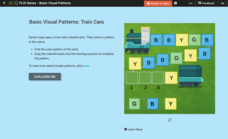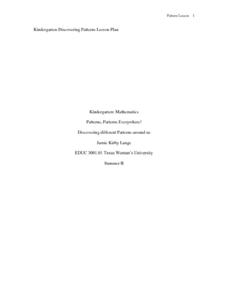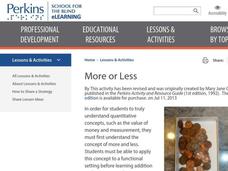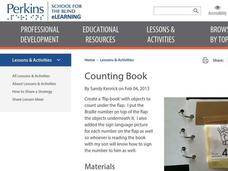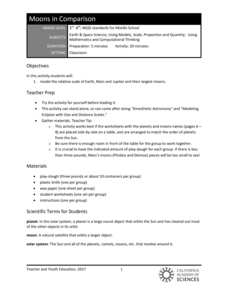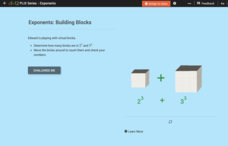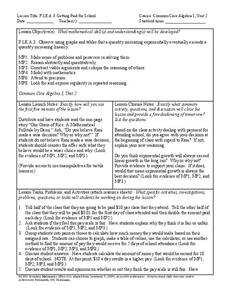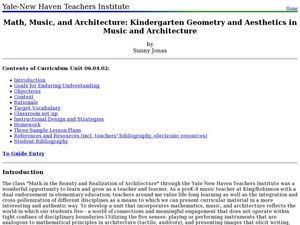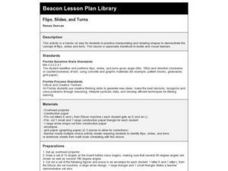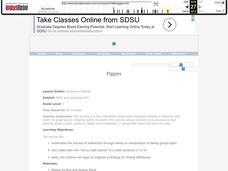Illustrative Mathematics
Pick Two
Learning to break apart numbers into smaller pairs is a critical step young mathematicians take as they develop their number sense. To practice this skill, children are provided with sets of three numbers and are asked to pick the two...
Bright Hub Education
Math Lesson for Visually Impaired Early Learners: A 3 Way Counting Activity
A unique lesson that's designed for visually impaired early learners, but can be adapted for anyone, is here for you. Pupils use brightly colored foam letters, beads, checkers, and an abacus, in order to gain practice in identifying the...
Math Salamanders Ltd.
Missing Subtraction facts to 12 sheet 1
Pupils subtract numbers one through 12 and complete missing addend problems. This worksheet includes a helpful number line and 20 problems to complete. Tip: Hand out unifix cubes or chips to help tactile learners solve each problem.
CK-12 Foundation
Basic Visual Patterns: Train Cars
An interactive comprised of five questions challenges young scholars to complete a simple pattern. After examining a train with colored carts, learners arrange a green, blue, and yellow block into their corresponding space. Questions are...
Texas Woman’s University
Patterns, Patterns Everywhere!
Not only is pattern recognition an essential skill for young children to develop, it's also a lot of fun to teach! Over the course of this lesson, class members participate in shared readings, perform small group...
Curated OER
Exploring Solving Equations
Put out by Texas Instruments, this lesson involves learners in an activity focused on adding polynomials, solving equations, factoring trinomials, and expanding binomials. A TI-89 calculator is needed to complete this lesson.
EngageNY
Definition of Translation and Three Basic Properties
Uncover the properties of translations through this exploratory instructional activity. Learners apply vectors to describe and verify transformations in the second installment of a series of 18. It provides multiple opportunities to...
Perkins School for the Blind
More or Less
The concept of more or less is one that needs to be mastered prior to learning other concepts such as quantitative analysis, addition, or subtraction. This activity provides several ways to teach learners with low or no vision to...
Perkins School for the Blind
Counting Book
Here is a wonderful way to teach children with visual impairments how to count and build number recognition skills. Included, you will find a set of instructions on how to create a counting book from card stock, jump rings, and cotton...
Curated OER
Using Manipulatives to Teach Fractions
There is no doubt that learners remember what they have learned when they have a visual representation. Using an egg carton and candy bars, they explore the concept of fractional amounts. By having learners cut the egg carton into parts...
Federal Reserve Bank
Expense Tracking
Where does all your money go? Individuals keep a record of the money they spend over the course of 30 days. They then categorize where they are spending their money and write an essay detailing their findings.
California Academy of Science
Moons in Comparison
Just how big is Earth's moon? With a hands-on simulation, scholars use Play-Doh to model the sizes of the planets Earth, Mars, Jupiter, and their moons. They make predictions as a class, work together to make their models, and discuss...
CK-12 Foundation
Whole Number Exponents: Building Blocks
Five questions make up an interactive all about whole-number exponents. Movable building blocks create a visual tool to aide mathematicians in answering multiple-choice and true or false problems. The interactive ends with a discussion...
Howard County Schools
Getting Paid for School
What if you were paid to attend class? What kind of payment schedule would you choose? Learn how exponential functions will eventually exceed linear functions by comparing two different payment schedules for attending class.
Curated OER
Math, Music and Architecture: Kindergarten Geometry and Aesthetics in Music and Architecture
Students identify and name different geometrical shapes. In this math lesson, students distinguish odd from even numbers. They describe the properties of 2 and 3 dimensional objects.
Curated OER
Addition and Subtraction using Manipulatives
Sixth graders participate in a question and answer session to begin their understanding. Students complete a practice assignment using color counters. Students' assessment is composed of using color counters to complete an independent...
Curated OER
Flips, Slides, and Turns
Fifth graders manipulate and draw shapes to demonstrate the concept of flips, slides, and turns using letters and arrows on graph paper.
Curated OER
Piggies
First graders listen to the book, Piggies, and act out the events of the story with premade puffball pigs.
Curated OER
Energy Audits for the Elderly
Young scholars perform experiments to determine the nature of energy particularly in air, light and water. They conducted an energy audit using the Energy Audit Checklist and by looking at the school's bills for gas and power.
Curated OER
Disappearing Magic Factors
Students identify, through the number of rows and columns, the factors related to the product. In turn, they also discover how to find the missing factor, which is part of the fact family for that product.



